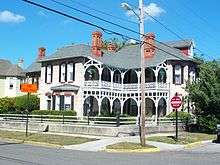Robert Sands Schuyler

Robert Sands Schuyler (1830-1895), often written as R. S. Schuyler and occasionally as R. V. Schuyler (perhaps from a bad NRHP transcription), was a New York architect, designer and religious leader who moved to Florida with his wife Caroline E. Acker (1840-1905) in 1881, joining prominent political, religious, and civil organizations on Amelia Island. He served as Clerk of the City of Fernandina, was Chair of the Fernandina Library Association when it was established in 1891, and was a lay reader at the Santa Fe, Florida, Episcopal congregation.
Early life
Schuyler was born, educated, and married in Troy, New York[1]
Carpenter Gothic churches
He designed churches in Santa Fe, Fairbanks, and Waldo, many in the Carpenter Gothic style. Carpenter Gothic architecture was developed by Richard Upjohn, whom Episcopal Bishop John Freeman Young of Florida had known while he was an assistant rector of Trinity Church in New York City. St. John's served as a model for various churches in Waldo, Fairbanks, as well as the St. Paul's By-The-Sea Episcopal Church in Pablo Beach which Schuyler designed in 1887. In Santa Fe, Schuyler designed St. John's Chapel on land donated by E.B. Ewing.[1]
Buildings in Fernandina Beach
He is credited with the Fairbanks House (Fernandina Beach, Florida), the Tabby House (Fernandina Beach, Florida) , and the Marcellus Williams Marcellus Williams House Williams House (Fernandina Beach, Florida),[2] all on Amelia Island's Fernandina Beach in Nassau County, Florida.[3] The Fairbanks House belonged to George Rainsford Fairbanks and is listed on the National Register of Historic Places.
Work
- George Fairbanks House
- Tabby House 7th and Ash Streets
- 1886 School House
- Hirth House
- St. Andrew's Episcopal Church (Jacksonville) 317 Florida Avenue, Jacksonville Gothic Revival 1887. Only remaining church from before the 1901 fire.[4]
- St. Peters Church, Fernandina (1884)[1]


